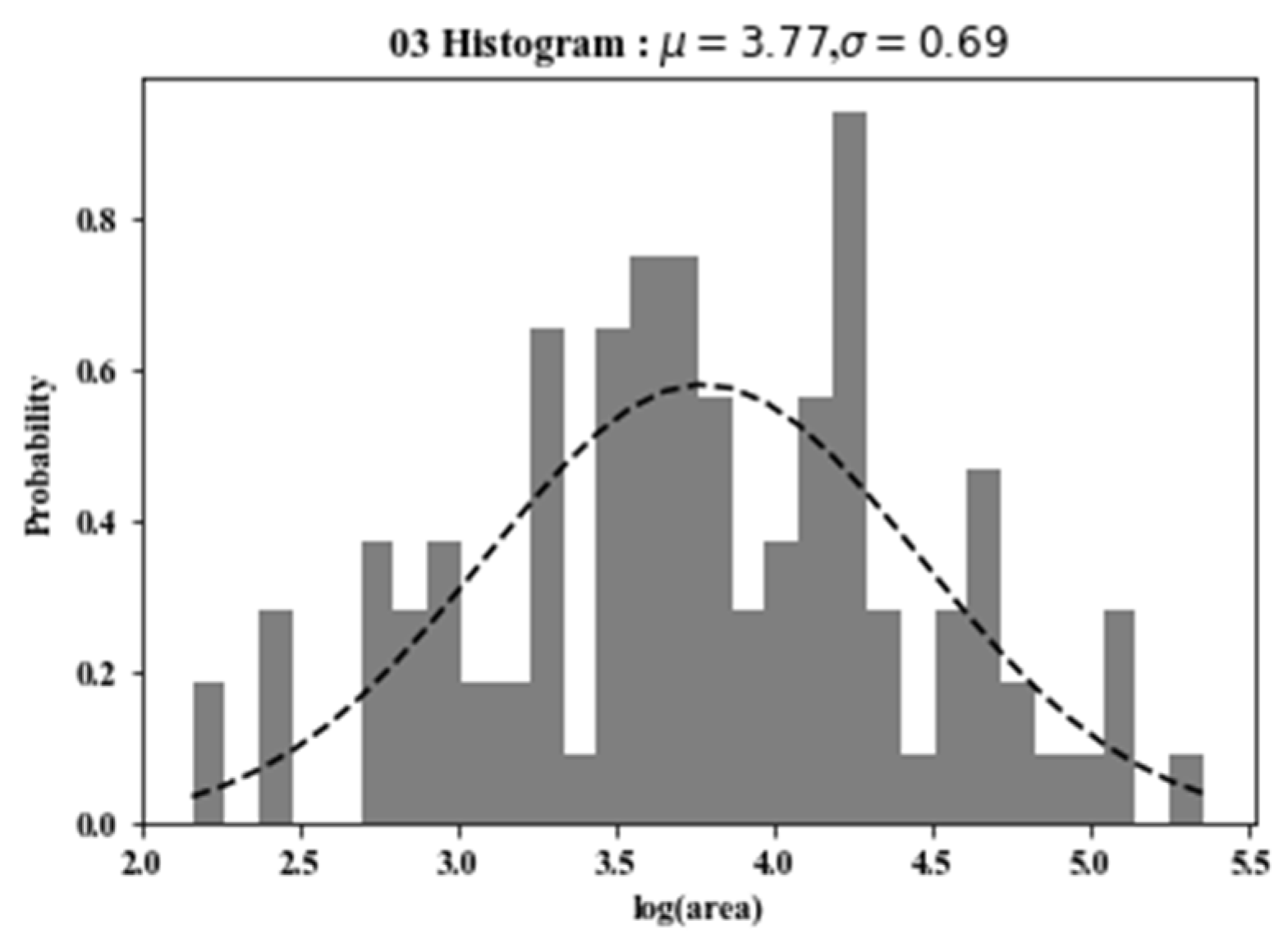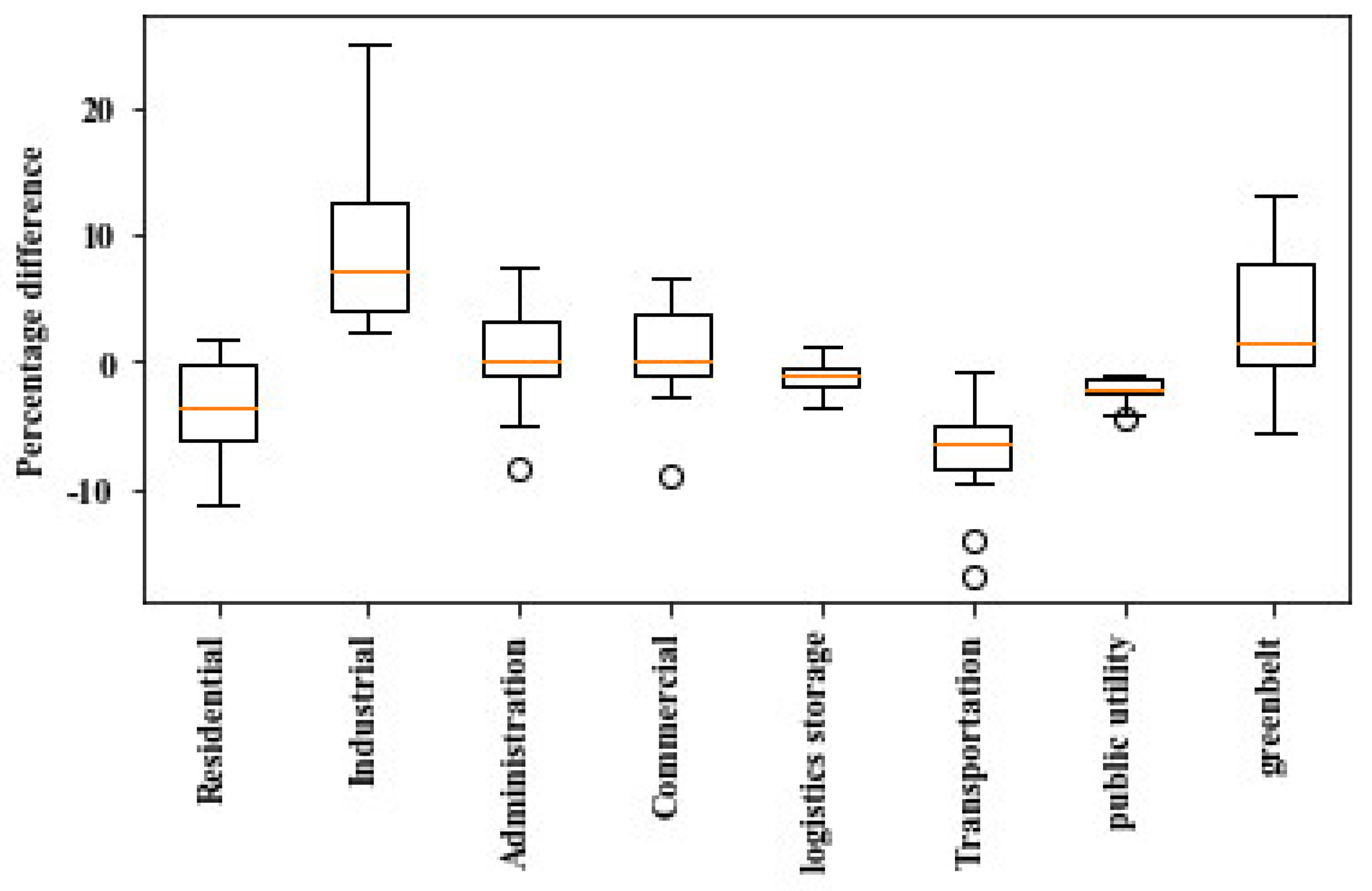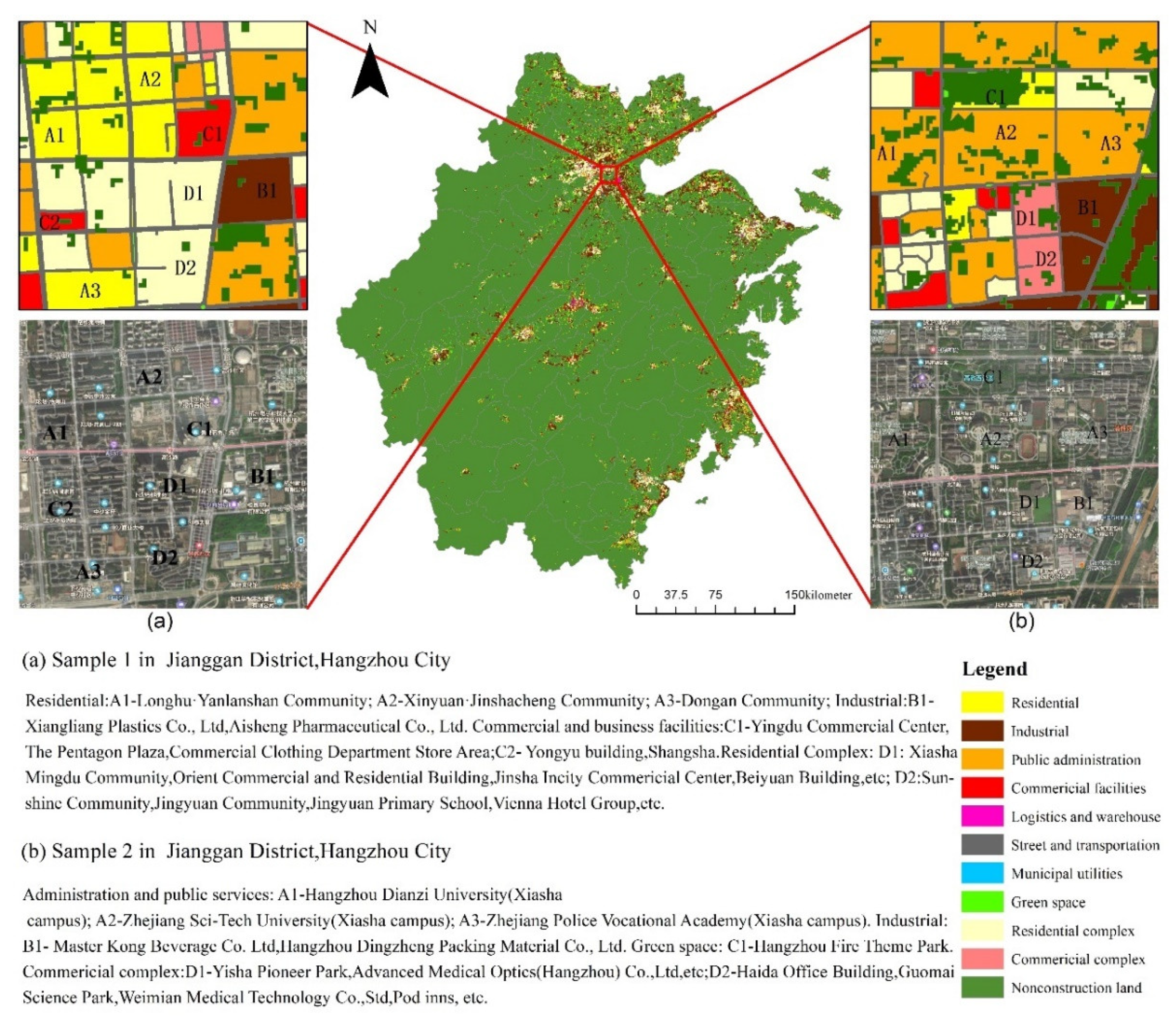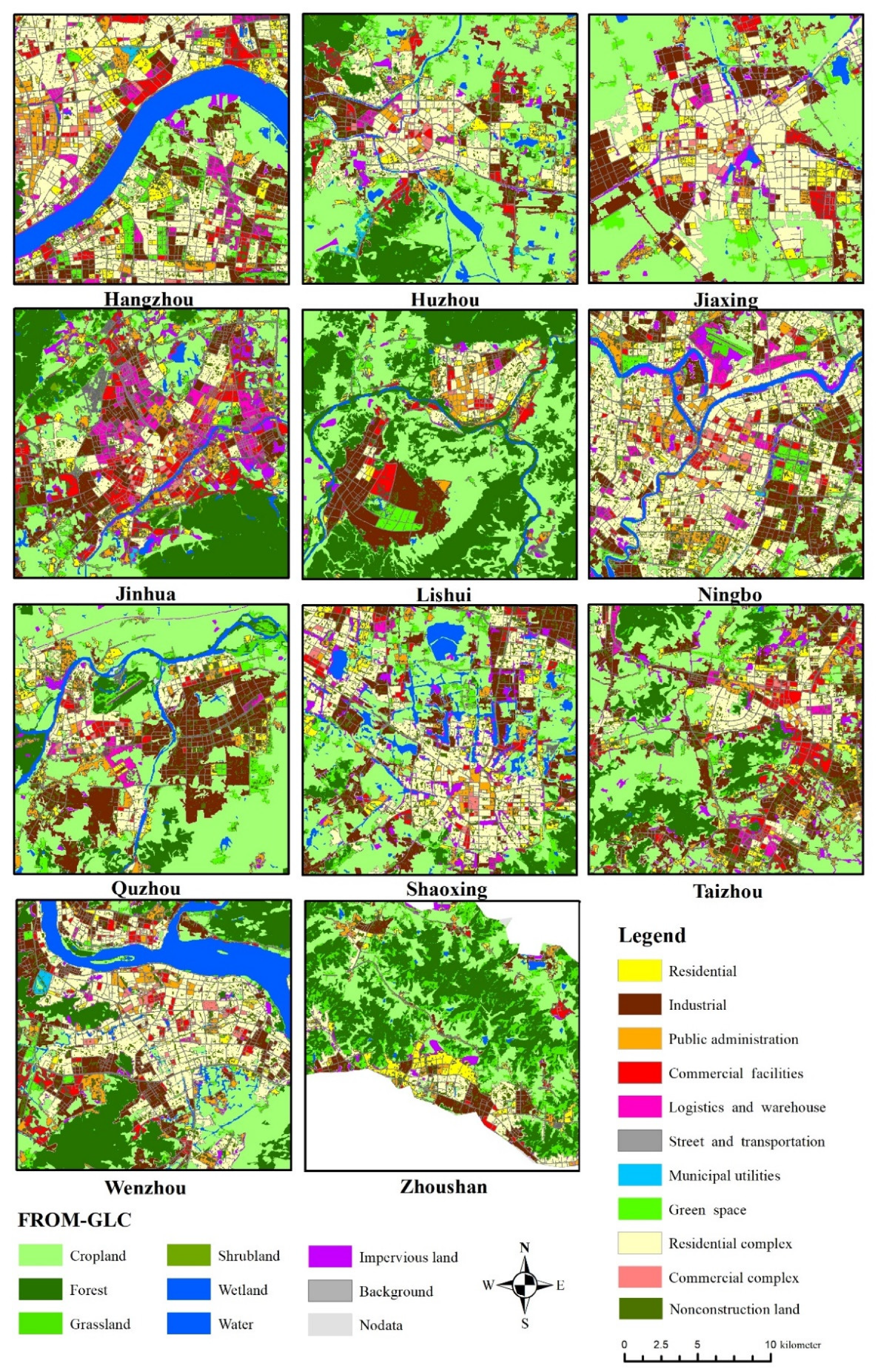Study on the Spatial Classification of Construction Land Types in Chinese Cities: A Case Study in Zhejiang Province
Abstract
:1. Introduction
2. Materials and Methods
2.1. Data Source
2.1.1. POI and Classification System
2.1.2. Nighttime Light Image
2.1.3. Impervious Land Data
2.1.4. Road Network
2.1.5. Land-Use Data
2.2. Classification Method
2.2.1. Measurement of Floor Area by Visual Interpretation
2.2.2. Assigning the Spatial Attributes of Urban Construction Land
2.2.3. Density-Based Spatial Clustering of Applications with Noise
2.2.4. Classification Method Based on Parcel Unit
3. Classification Accuracy and Results
3.1. Verification of Classification Accuracy
3.2. Results of the Construction Land Classification
4. Discussion
5. Conclusions
Author Contributions
Funding
Data Availability Statement
Conflicts of Interest
Appendix A


References
- Greenberg, M.; Goldstein, B.D.; Anderson, E.; Dourson, M.; Landis, W.; North, D.W. Whither Risk Assessment: New Challenges and Opportunities a Third of a Century After the Red Book. Risk Anal. 2015, 35, 1959–1968. [Google Scholar] [CrossRef] [PubMed]
- The World Bank. Available online: https://documents.worldbank.org/en/publication/documents-reports/documentdetail/229791468159607825/economics-of-coastal-zone-adaptation-to-climate-change (accessed on 15 January 2021).
- Wu, J.; Han, G.; Zhou, H.; Li, N. Economic development and declining vulnerability to climate-related disasters in China. Environ. Res. Lett. 2018, 13, 034013. [Google Scholar] [CrossRef]
- Adger, W.N. Vulnerability. Glob. Environ. Chang. 2006, 16, 268–281. [Google Scholar] [CrossRef]
- Li, G.; Sun, S.; Fang, C. The varying driving forces of urban expansion in China: Insights from a spatial-temporal analysis. Landsc. Urban Plan. 2018, 174, 63–77. [Google Scholar] [CrossRef]
- Neuhaus, F. Emergent Spatio Temporal Dimensions of the City; Springer: Cham, Switzerland, 2015; pp. 13–36. [Google Scholar] [CrossRef]
- Foody, G.M. Status of land cover classification accuracy assessment. Remote Sens. Environ. 2002, 80, 185–201. [Google Scholar] [CrossRef]
- Copernicus Global Land Services. Available online: https://land.copernicus.eu/global/products/lc (accessed on 20 March 2021).
- Xie, H. Towards Sustainable Land Use in China: A Collection of Empirical Studies. Sustainability 2017, 9, 2129. [Google Scholar] [CrossRef] [Green Version]
- Zhong, Y.; Su, Y.; Wu, S. Open-source data-driven urban land-use mapping integrating point-linepolygon semantic objects: A case study of Chinese cities. Remote Sens. Environ. 2020, 247, 111838. [Google Scholar] [CrossRef]
- Soliman, A.; Soltani, K.; Yin, J. Social sensing of urban land use based on analysis of twitter users’ mobility patterns. PLoS ONE 2017, 12, e0181657. [Google Scholar] [CrossRef] [Green Version]
- McKenzie, G.; Janowicz, K.; Gao, S. Poi pulse: A multi-granular, semantic signature-based information observatory for the interactive visualization of big geosocial data. Cartographica 2015, 50, 71–85. [Google Scholar] [CrossRef]
- Gong, P.; Chen, B.; Li, X. Mapping essential urban land use categories in china (EULUC-China): Preliminary results for 2018. Sci. Bull. 2020, 65, 182–187. [Google Scholar] [CrossRef] [Green Version]
- Hu, T.; Yang, J.; Li, X.; Gong, P. Mapping Urban Land Use by Using Landsat Images and Open Social Data. Remote Sens. 2016, 8, 151. [Google Scholar] [CrossRef]
- Li, X.; Hu, T.; Gong, P.; Du, S.; Chen, B.; Li, X.; Dai, Q. Mapping Essential Urban Land Use Categories in Beijing with a Fast Area of Interest (AOI)-Based Method. Remote Sens. 2021, 13, 477. [Google Scholar] [CrossRef]
- Yao, Y.; Li, X.; Liu, X.; Liu, P.; Liang, Z.; Zhang, J.; Mai, K. Sensing spatial distribution of urban land use by integrating points-of-interest and google word2vec model. Int. J. Geogr. Inf. Sci. 2017, 31, 825–848. [Google Scholar] [CrossRef]
- Zhai, W.; Bai, X.; Shi, Y. Beyond word2vec: An approach for urban functional region extraction and identification by combining place2vec and pois. Comput. Environ. Urban Syst. 2019, 74, 1–12. [Google Scholar] [CrossRef]
- Gao, S.; Janowicz, K.; Couclelis, H. Extracting urban functional regions from points of interest and human activities on location-based social networks. Trans. GIS 2017, 21, 446–467. [Google Scholar] [CrossRef]
- Yuan, J.; Zheng, Y.; Xie, X. Discovering Regions of Different Functions in a City Using Human Mobility and POIs. In Proceedings of the 18th ACM SIGKDD International Conference on Knowledge Discovery and Data Mining, Beijing, China, 12–16 August 2012; Association for Computing Machinery: New York, NY, USA, 2012. [Google Scholar] [CrossRef]
- Gu, Y.; Jiao, L.; Dong, T. Spatial distribution and interaction analysis of urban functional areas based on multi-source data. Geomat. Inf. Sci. Wuhan Univ. 2018, 43, 1113–1121. (In Chinese) [Google Scholar] [CrossRef]
- Xu, S.; Qing, L.; Han, L.; Liu, M.; Peng, Y.; Shen, L. A New Remote Sensing Images and Point-of-Interest Fused (RPF) Model for Sensing Urban Functional Regions. Remote Sens. 2020, 12, 1032. [Google Scholar] [CrossRef] [Green Version]
- Song, J.; Lin, T.; Li, X.; Prishchepov, A.V. Mapping Urban Functional Zones by Integrating Very High Spatial Resolution Remote Sensing Imagery and Points of Interest: A Case Study of Xiamen, China. Remote Sens. 2018, 10, 1737. [Google Scholar] [CrossRef] [Green Version]
- Sun, J.; Wang, H.; Song, Z.; Lu, J.; Meng, P.; Qin, S. Mapping Essential Urban Land Use Categories in Nanjing by Integrating Multi-Source Big Data. Remote Sens. 2020, 12, 2386. [Google Scholar] [CrossRef]
- Zhou, Y.; Smith, S.J.; Elvidge, C.D.; Zhao, K.; Thomson, A.; Imhoff, M. A cluster-based method to map urban area from DMSP/OLS nightlights. Remote Sens. Environ. 2014, 147, 173–185. [Google Scholar] [CrossRef]
- Schwarz, N. Urban form revisited—Selecting indicators for characterising European cities. Landsc. Urban Plan. 2010, 96, 29–47. [Google Scholar] [CrossRef]
- Ester, M.; Kriegel, H.; Sander, J. A Density-Based Algorithm for Discovering Clusters in Large Spatial Databases with Noise. In Proceedings of the Second International Conference on Knowledge Discovery and Data Mining (KDD-96), Portland, OR, USA, 2–4 August 1996; AAAI Press: Portland, OR, USA, 1996. [Google Scholar]
- Schubert, E.; Sander, J.; Ester, M. Dbscan revisited, revisited: Why and how you should (still) use dbscan. ACM Trans. Database Syst. 2017, 42, 1–21. [Google Scholar] [CrossRef]
- Shen, J.; Hao, X.; Liang, Z. Real-time superpixel segmentation by dbscan clustering algorithm. IEEE Trans. Image Process. 2016, 25, 5933–5942. [Google Scholar] [CrossRef] [PubMed] [Green Version]
- Ministry of Housing and Urban-Rural Development of People’s Republic China. Code for Classification of Urban and Rural Land Use and Planning Standards of Development Land (GB50137-2011); China Architecture & Building Press: Beijing, China, 2011; (In Chinese).
- Elvidge, C.D.; Baugh, K.E.; Zhizhin, M.; Hsu, F.-C. Why VIIRS data are superior to DMSP for mapping nighttime lights. In Proceedings of the Asia-Pacific Advanced Network, Honolulu, HI, USA, 13–16 January 2013. [Google Scholar]
- Gong, P.; Li, X.; Wang, J. Annual maps of global artificial impervious area (gaia) between 1985 and 2018. Remote Sens. Environ. 2020, 236, 111510. [Google Scholar] [CrossRef]
- Gong, P.; Wang, J.; Yu, L. Finer resolution observation and monitoring of global land cover: First mapping results with Landsat TM and ETM+ data. Int. J. Remote Sens. 2013, 34, 2607–2654. [Google Scholar] [CrossRef] [Green Version]
- Ministry of Natural Resources of the People’s Republic of China. Current Land Use Classification (GB/T 21010-2017); Standards Press of China: Beijing, China, 2017; (In Chinese).
- Liu, X.; Long, Y. Automated identification and characterization of parcels with openstreetmap and points of interest. Environ. Plan. B Plan. Des. 2016, 43, 341–360. [Google Scholar] [CrossRef]
- Zhang, L. Research on poi classification standard. Bull. Surv. Mapp. 2012, 10, 82–84. (In Chinese) [Google Scholar]
- Xu, H.; Zhu, J.; Wang, Z. Exploring the spatial pattern of urban block development based on poi analysis: A case study in Wuhan, China. Sustainability 2019, 11, 6961. [Google Scholar] [CrossRef] [Green Version]
- Li, X.; Xue, X. Estimation method of nighttime light images’electric power consumption based on the boston matrix. Geomat. Inf. Sci. Wuhan Univ. 2018, 43, 1994–2002. (In Chinese) [Google Scholar]
- Li, F.; Yan, Q.; Zou, Y.; Liu, B. Improving the Accuracy of Built-up Area Extraction Based on Nighttime Light Data and POI: A Case Study of NPP/VIIRS and Luojia 1-01 Nighttime Light Images. Wuhan Univ. Nat. Sci. 2019, 1–14. (In Chinese) [Google Scholar] [CrossRef]
- Silverman, B.W. Density Estimation for Statistics and Data Analysis. Technometrics 2012, 29, 495. [Google Scholar] [CrossRef]
- Zhou, Z.; Wang, J.; Zhu, S. An improved adaptive and fast af-dbscan clustering algorithm. CAAI Trans. Intell. Syst. 2016, 11, 93–98. (In Chinese) [Google Scholar]
- CCCC FIRST HIGHWAY CONSULTANTS. The Highway Route Design Specification (JTG D20-2017); China Communication Press: Beijing, China, 2018. (In Chinese) [Google Scholar]
- Hu, M.Z.; Fan, Y.H.; Zhao, Q.Q. A Study of HOPSCA Development under the Intensive Land Use. Appl. Mech. Mater. 2011, 71, 589–593. [Google Scholar] [CrossRef]
- Qin, Z.; Yu, Y.; Liu, D. The effect of hopsca on residential property values: Exploratory findings from Wuhan, China. Sustainability 2019, 11, 471. [Google Scholar] [CrossRef] [Green Version]
- Jiang, H. Commercial Complex and Urban Public Space. Mod. Urban Res. 2009, 24, 48–52. (In Chinese) [Google Scholar]




| Land-Use Type | Code | POI Type | Ground Area | 95% Confidence Interval | |
|---|---|---|---|---|---|
| Nonconstruction | 01 | Agricultural, forestry, animal husbandry and fishery bases | - | - | |
| Residential | 02 | Living quarters | - | - | |
| Industrial | 03 | Companies, factories, industrial parks, well-known enterprises | 5921 | 4320–8118 | |
| Administrative and public services | 04 | 41 | Government agencies, social institutions, service-oriented venues | 14,737 | 9665–22,470 |
| 42 | General hospitals, emergency centers | 2078 | 806–5361 | ||
| 43 | Schools and research institutes | 4112 | 2485–6802 | ||
| Commercial and business facilities | 05 | 51 | Convention and exhibition centers, commercial venues | 1860 | 1388–3494 |
| 52 | Comprehensive markets, shopping malls and large commercial places | 816 | 621–1073 | ||
| 53 | Commercial service institutions such as banks and gas stations | 543 | 423–698 | ||
| Logistics and warehouse | 06 | Logistics storage | 98 | 74–130 | |
| Street and transportation | 07 | 71 | Wharves, airports, railway stations and transit ports | 3336 | 2177–5232 |
| 72 | Parking lots, long-distance bus stations, subways, etc. | 463 | 366–587 | ||
| Municipal utilities | 08 | Emergency shelters | 2710 | 1989–3695 | |
| Green space | 09 | Scenic spots, parks and squares | 3183 | 2013–5034 | |
| Code | POI Type | Cluster | Eps | MinPts | |
|---|---|---|---|---|---|
| 03 | Companies, factories, industrial parks, well-known enterprises | √ | 3 | 5 | |
| 04 | 41 | Government agencies, social institutions, service-oriented venues | √ | 4 | 6 |
| 42 | General hospital, emergency center | - | - | ||
| 43 | Schools and research institutes | √ | 4 | 3 | |
| 05 | 51 | Convention and exhibition centers, commercial venues | √ | 3 | 5 |
| 52 | Comprehensive market, shopping mall and other large commercial places | √ | 4 | 10 | |
| 53 | Commercial service institutions such as Banks and gas stations | √ | 4 | 4 | |
| 06 | logistics storage | √ | 20 | 3 | |
| 07 | 71 | Wharves, airports, railway stations and transit ports | × | - | - |
| 72 | Parking lots, long-distance bus stations, subways, etc. | × | - | - | |
| 08 | Emergency shelter | × | - | - | |
| 09 | Scenic spots, parks and squares | × | - | - | |
| Code | 03 | 04 | 05 | 06 | 07 | 08 | Total | UA (%) |
|---|---|---|---|---|---|---|---|---|
| 03 | 330237 | 13088 | 23856 | 5790 | 290 | 643 | 373904 | 88.32 |
| 04 | 16006 | 148311 | 51560 | 3599 | 118 | 351 | 219945 | 67.43 |
| 05 | 20152 | 31226 | 141245 | 2692 | 253 | 90 | 195658 | 72.19 |
| 06 | 13689 | 5902 | 14507 | 57379 | 57 | 35 | 91569 | 62.66 |
| 07 | 7 | 21 | 23 | 7 | 282 | 3 | 343 | 82.22 |
| 08 | 180 | 82 | 92 | 1 | 76 | 1356 | 1787 | 75.88 |
| ACC 1 (%) | 76.86 | |||||||
| Type | 02 | 03 | 04 | 05 | 06 | 07 | 08 | 09 | |
|---|---|---|---|---|---|---|---|---|---|
| City | Res | Ind | PA | CF | LW | ST | MF | GS | |
| Hangzhou | 27.05 | 31.98 | 5.29 | 7.14 | 3.15 | 10.09 | 0.47 | 14.80 | |
| Huzhou | 26.83 | 31.39 | 6.49 | 7.65 | 0.27 | 8.21 | 0.74 | 18.09 | |
| Jiaxing | 28.33 | 35.01 | 6.29 | 6.23 | 0.60 | 8.25 | 0.63 | 14.67 | |
| Jinhua | 25.57 | 27.69 | 8.89 | 11.69 | 2.08 | 12.48 | 0.26 | 11.34 | |
| Lishui | 20.69 | 32.36 | 12.82 | 9.91 | 0.17 | 10.64 | 1.18 | 12.23 | |
| Ningbo | 22.94 | 36.21 | 7.10 | 6.30 | 1.71 | 10.76 | 0.21 | 14.76 | |
| Quzhou | 25.30 | 33.51 | 11.21 | 7.62 | 1.30 | 0.45 | 0.66 | 19.97 | |
| Shaoxing | 23.40 | 36.51 | 6.81 | 7.16 | 0.49 | 10.42 | 0.56 | 14.65 | |
| Taizhou | 27.81 | 29.90 | 13.43 | 9.38 | 0.89 | 11.08 | 0.23 | 7.27 | |
| Wenzhou | 22.01 | 27.52 | 15.11 | 8.57 | 0.16 | 10.90 | 0.43 | 15.29 | |
| Zhoushan | 37.97 | 24.40 | 7.93 | 4.56 | 0.92 | 11.01 | 0.10 | 13.10 | |
Publisher’s Note: MDPI stays neutral with regard to jurisdictional claims in published maps and institutional affiliations. |
© 2021 by the authors. Licensee MDPI, Basel, Switzerland. This article is an open access article distributed under the terms and conditions of the Creative Commons Attribution (CC BY) license (https://creativecommons.org/licenses/by/4.0/).
Share and Cite
Dong, L.; Li, J.; Xu, Y.; Yang, Y.; Li, X.; Zhang, H. Study on the Spatial Classification of Construction Land Types in Chinese Cities: A Case Study in Zhejiang Province. Land 2021, 10, 523. https://doi.org/10.3390/land10050523
Dong L, Li J, Xu Y, Yang Y, Li X, Zhang H. Study on the Spatial Classification of Construction Land Types in Chinese Cities: A Case Study in Zhejiang Province. Land. 2021; 10(5):523. https://doi.org/10.3390/land10050523
Chicago/Turabian StyleDong, Lin, Jiazi Li, Yingjun Xu, Youtian Yang, Xuemin Li, and Hua Zhang. 2021. "Study on the Spatial Classification of Construction Land Types in Chinese Cities: A Case Study in Zhejiang Province" Land 10, no. 5: 523. https://doi.org/10.3390/land10050523
APA StyleDong, L., Li, J., Xu, Y., Yang, Y., Li, X., & Zhang, H. (2021). Study on the Spatial Classification of Construction Land Types in Chinese Cities: A Case Study in Zhejiang Province. Land, 10(5), 523. https://doi.org/10.3390/land10050523






